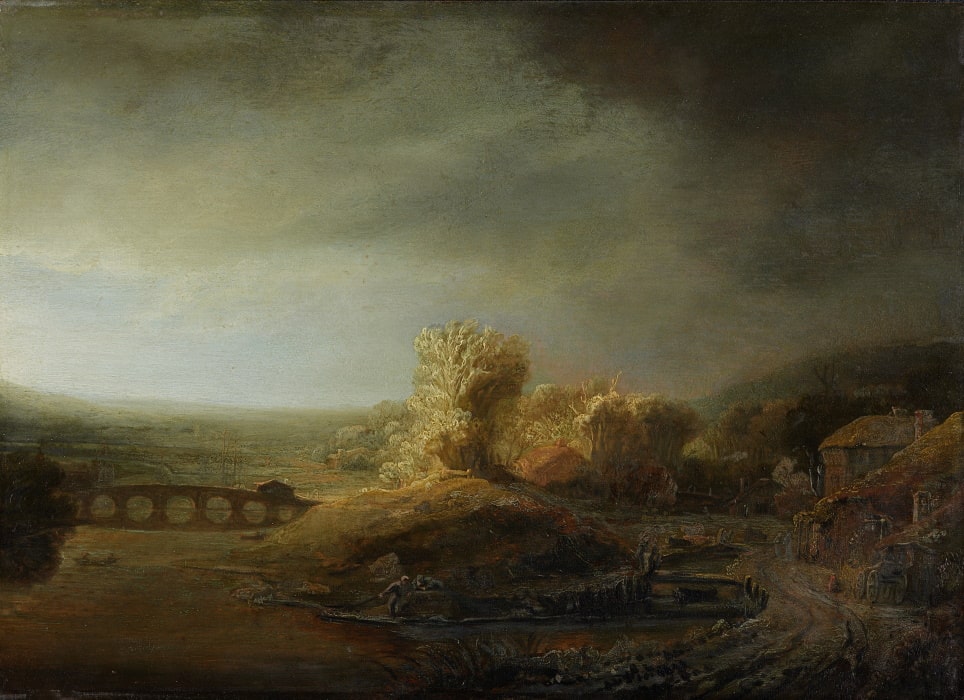For more than 30 years, the painting “Landscape with Arched Bridge” was considered to be the work of Rembrandt’s student Govert Flinck. According to the latest research, however, the work is by the master himself and from now on completes the globally important Rembrandt holdings of the Berlin Gemäldegalerie. From April 8th 2022, the painting will be on display in the special exhibition “David Hockney – Landscapes in Dialogue. The Four Seasons” of the Würth Collection at the Gemäldegalerie.
Image above: Rembrandt Harmensz. van Rijn, Landscape with Arched Bridge, c. 1638, wood, © Staatliche Museen zu Berlin, Gemäldegalerie / Christoph Schmidt
When the “Landscape with Arched Bridge” (Cat. No. 1932) entered the collection of the Gemäldegalerie in 1924, it was still considered to be Rembrandt’s own work. For Wilhelm von Bode, then Director General of the Royal Museums and an internationally renowned Rembrandt specialist, this was the fulfilment of a wish he had cherished for several decades. With the hitherto missing landscape, he was able to close an important gap for Berlin and complete Berlin’s outstanding Rembrandt holdings.
The painting comes from the collection of Grand Duke Friedrich August von Oldenburg (1852-1931), whose painting holdings were destroyed in 1918 after his forced abdication. Presumably in September 1919, the former Grand Duke had around 115 of his best works transported to the Netherlands largely unnoticed in a night-and-fog operation, where they ended up at the Amsterdam auction house Frederik Muller & Cie. From there, a selection of 40 top works was sent to the USA for sale, including the “Landscape with Arched Bridge” attributed to Rembrandt. According to Bode, however, the work did not sell because of the high price and the small picture format of 28.5 x 39.5 cm. In 1923 it passed into the possession of the art dealers Paul Cassirer and Julius Böhler. A year later, the landscape was finally acquired for the Kaiser Friedrich Museum in exchange for three works from the collection – an extremely fortunate transaction for the Gemäldegalerie, as it no longer had sufficient funds to make such a high-profile purchase.
Until the 1980s, “Landscape with Arched Bridge” was considered an authentic work by Rembrandt Harmensz. van Rijn. However, in 1989, following an investigation by the Rembrandt Research Project, it was written off and attributed to Rembrandt’s pupil Govert Flinck. The decisive factor for the write-off was above all the comparison with the painting “Landscape with Stone Bridge” in the Rijksmuseum in Amsterdam. The Rembrandt Research Project pointed out the astonishingly far-reaching technical and motivic similarities between the Berlin painting and other landscape depictions by Rembrandt, especially the Amsterdam work. However, it was precisely this observation that subsequently served as the decisive argument for attributing the Berlin painting to a successor or imitator of the master.
However, current examinations of the Berlin painting and the evaluation of technical recordings, which were not yet available in 1989, have now confirmed the work’s originality. Thus, changes and corrections in the painting that were made during the painting process can be identified. In this way, the development of the composition with its masterly lighting and atmospheric chiaroscuro contrasts becomes comprehensible. In contrast, the Amsterdam painting is hardly distinguished by any altering interventions by the artist. Accordingly, the work in the Gemäldegalerie should probably be regarded not as a successor but as a precursor to the Amsterdam landscape. This conclusion is further supported by the dendrochronological findings, which point to a later date of origin for the Amsterdam painting. The major revisions Rembrandt made to the Berlin work also explain the striking differences in the painting style of the two pictures. In the Berlin version it is comparatively dense and compact, in the following Amsterdam version it is translucent and at the same time precise.
Although Rembrandt painted only a few landscapes, they were stylistically and compositionally groundbreaking for later generations of artists. Above all, through his masterfully staged and dramatically sharpened use of light, he created atmospheres that were extraordinarily atmospheric for landscape painting in the 17th century. At present, only seven landscape paintings are known from Rembrandt’s oeuvre. With the reattribution of the Berlin painting, this number now increases to eight works.
The Gemäldegalerie owns one of the world’s most important and extensive collections of works by Rembrandt Harmensz. van Rijn. With “Landscape with Arched Bridge”, this important complex of works now comprises 20 works. As with the acquisition of the painting around 100 years ago, an important gap can thus be closed and the holdings can be happily completed.
The painting will be on display from April 8th 2022 in the special exhibition “David Hockney – Landscapes in Dialogue. The “Four Seasons” of the Würth Collection as a guest in Berlin”. In it, Hockney’s large-scale seasonal cycle “Three Trees near Thixendale” from the Würth Collection enters into an impressive dialogue with landscape depictions from the collections of the Gemäldegalerie, the Nationalgalerie and the Kupferstichkabinett. In this way, Hockney’s engagement with the art of previous centuries and parallels to great models such as Rembrandt, Vincent van Gogh and John Constable become comprehensible.
WHEN?
Special exhibition: Saturday, April 9th – Sunday, July 10th 2022
Special opening hours: Tue – Fri 10 am – 6 pm, Sat + Sun 11 am – 6 pm
WHERE?
Kulturforum, Gemäldegalerie
Matthäikirchplatz
10785 Berlin-Tiergarten






